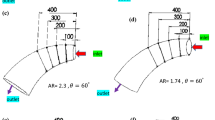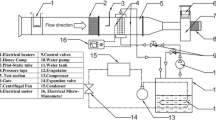Abstract
The use of more efficient energy consuming devices, which are closely associated with reduction of environmental pollution, has gained significant interest in the recent decades. The reduction of drag coefficient also improves safety and durability of environmental structures subjected to high-velocity fluid flow, and causes the noise and vibration to decrease as well. This paper describes the efficiency improvement in energy management by means of reducing drag coefficient in a practical divergent tubular-truncated cone. Extensive numerical simulations with emphasis on the shape optimization study were performed in order to find minimum drag coefficient for both laminar and turbulent flows (9.41 × 102 ≤ Re ≤ 1.882 × 107) around the mentioned cone. The numerical results were validated with experimental data, obtained by performing tests in an open circuit wind tunnel. The results showed that the minimum drag coefficient of optimum model within the shape modification process, comparable to the value for the primary model in turbulent flow decreased by 69.8% (the maximum discrepancy) at the highest considered Reynolds number of 1.882 × 107. Furthermore, the study of streamwise velocity profile led to more useful result. In this regard, the velocity magnitude inside the inlet span of the primary model, close to the entrance was approximately 1.6 times as great as the free upstream velocity. This is a noticeable result for the use of efficiency important structures in industrial applications.








Similar content being viewed by others
References
Aiba S (1998) Flow dynamic drag of an axially symmetrical bluff body consisting of a plane surface and a spherical surface. J. Fluids Eng 120(4):851–853
Alvarez A, Bertram V, Gualdesi L (2009) Hull hydrodynamic optimization of autonomous underwater vehicles operating at snorkeling depth. J Ocean Eng 36(1):105–112
Anderson JD (2005) Fundamentals of Aerodynamics, 4th edn. McGrow Hill Inc, Columbus
Bearman PW (1997) Near wake flows behind two- and three-dimensional bluff bodies. J Wind Eng Ind Aerodyn 69–71(1):33–54
Bong-Huan J, Jin-Yeong P, Fill-Youb L, Pan-Mook L, Chong-Moo L, Kihun K, Young-Kon L, Jun-Ho O (2009) Development of the AUV ‘ISMI’ and a free running test in an ocean engineering basin. J Ocean Eng 36(1):2–14
Calvert JR (1967) Experiments on the low speed flow past cones. J Fluid Mech 27(2):273–289
Cengel YA, Cimbala JM (2010) Fluid mechanics: fundamentals and applications, 2nd edn. McGrow Hill Inc., New york, pp 580–590
Cheng M, Liu GR (2000) Effect of after body shape on flow around prismatic cylinders. J Wind Eng Ind Aerodyn 84(2):181–196
Fluent 6.3 User’s Guide (2006) Fluent Inc., Lebanon, p 03766
Jafari Gavzan I, Rad M (2009) Experimental analysis of cavitation effects on drag force and back pressure of circular cylinder with free turbulence. Sci Iran 16(4):344–353
Jagadeesh P, Murali K, Idichandy VG (2008) Experimental investigation of hydrodynamic force coefficients over AUV hull form. J Ocean Eng 36(1):113–118
Jiaming W, Jiawei Y, Cheng Y, Yuanming C, Huiping T, Xiaohui X (2005) Experimental study on a controllable underwater towed system. J Ocean Eng 32(14–15):1803–1817
Jones GW, Cincotta JJ, RWb Walker (1969) Aerodynamic forces on a stationary and oscillating circular cylinder at high Reynolds numbers. NASA Tech Rep R 300:1–62
Karim M, Rahman M, Alim A (2008) Numerical computation of viscous drag for axisymmetric under water vehicles. J. Mek 26(1):9–21
Kim JW, Morris JPh (2002) Computation of subsonic inviscid flow past a cone using high-order scheme. J AIAA 40(10):1961–1968
Koide M, Okanaga H, Aoki K (2006) Drag reduction effect of square cylinders by grooves and corner-cuttings. J Visual Soc Jpn 26(1):69–72
Kumar M, Subramanian A (2007) A numerical and experimental study on tank wall influences in drag estimation. J Ocean Eng 34(1):192–205
Lin CW, Percival S, Gotimer EH (1995) Viscus drag calculations for ship hull geometry. Tech Rep, Design evaluation branch, Hydromechanics directorate, David Taylor Model Basin, Carderock Division Naval Surface Warfare Center, Bethesda, MD, USA
Lourenco LM, Shih C (1993) Characteristics of the plane turbulent near wake of a circular cylinder: a particle image velocimetry study, Private Communication
Matsuda k, Uejima H, Sugimoto T (2003) Wind tunnel test on in-line oscillation of a two-dimensional circular cylinder. J Wind Eng Ind Aerodyn 1-2:83–90
Niknafs AY (2010) Experimental investigation of drag on tubular frustum immersed in a water moving in different directions and variation of drag coefficient. M.Sc. Dissertation, IAU (South Tehran Branch), Iran
Rahman M, Karim M, Alim M (2007) Numerical investigation of unsteady flow past a circular cylinder using 2-D finite volume method. J Navig Archit Mar Eng 4(1):27–42
Sakai T (2009) Supersonic drag performance of truncated cones with repetitive energy depositions. Int J Aerosp Innov 1(1):31–43
Sarkar T, Sayer PG, Fraser SM (1997) A study of autonomous underwater vehicle hull forms using computational fluid dynamics. Int J Numer Meth Fluids 25(11):1301–1313
Sayer P (1996) Hydrodynamics forces on ROV near the air/sea interface. Int J Offshore Polar Eng 6(3):177–183
Sung CH, Fu TC, Griffin MJ, Huang TT (1997) Validation of incompressible flow computation of forces and moments on axisymmetric bodies undergoing constant radius turning. In: Proceedings of the 21 symposium on naval hydrodynamics, pp 1048–1060
Terry J, Barber T (2007) CFD and experimental study of an inflatable re-entry vehicle model at Mach 3 conditions. J Acta Astronautica 61(10):854–865
Tutar M, Holdo AE (2001) Computational modeling of flow around a circular cylinder in sub-critical flow regime with various turbulence models. Int J Numer Meth Fluids 35(1):763–784
Vakil A, Green SI (2009) Drag and lift coefficients of inclined circular cylinders at moderate Reynolds numbers. J Comput Fluids 38(9):1771–1781
Zasso A, Giappino S, Muggiasca S (2006) Wind tunnel study of a cone-like shaped roof: Reynolds number effects. J Wind Eng Ind Aerodyn 94(5):431–444
Acknowledgments
The authors would like to express their gratitude toward the authorities of IAU, Science and Research Aerodynamic Laboratory, where the experimental tests were performed.
Author information
Authors and Affiliations
Corresponding author
Rights and permissions
About this article
Cite this article
Lotfi, A., Rad, M. Drag performance of divergent tubular-truncated cones: a shape optimization study. Int. J. Environ. Sci. Technol. 9, 105–112 (2012). https://doi.org/10.1007/s13762-011-0003-9
Received:
Revised:
Accepted:
Published:
Issue Date:
DOI: https://doi.org/10.1007/s13762-011-0003-9




